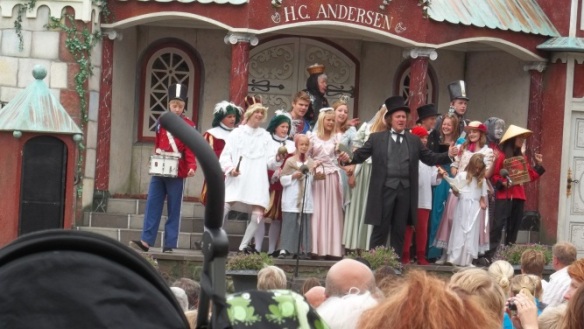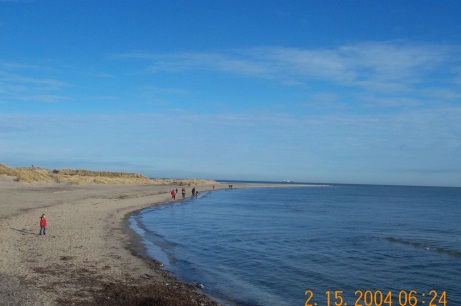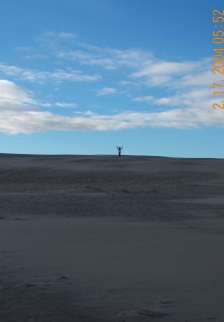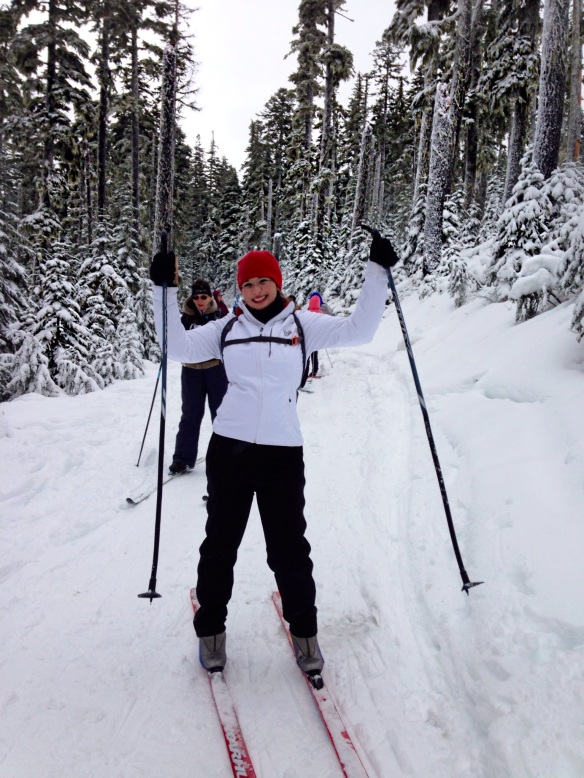Sometimes I’ve joked that I have two things in common with Hans Christian Andersen: we were both born in Odense and we both left – he at an earlier age than I, but I went farther away. Having grown up in a city with his “foot prints” all over has given me a certain feeling of “ownership”, and with that, I think a feeling of responsibility to share him. H. C. Andersen – as he is known to Danes – was born on April 2, 1805. He was born in Odense in the small yellow house on the corner of Hans Jensen Stræde and Bangs Boder – now known world-wide from postcards and photos.
 When he was two years old, he and his parents moved to an even smaller house in Munkemølle Stræde. He was the only child of impoverished parents. His father was a cobbler. He was a bitter and disappointed man (who possibly drank too much) and never had the opportunity for an education. He was, however, devoted to his son and probably responsible for igniting the creative streak in the boy. While the mother was illiterate, the father would read to Hans Christian from some of the great writers of the 17th century as well as from The Arabian Nights, form where HCA later borrowed material for several of his tales. The father would on occasion take him to the theater, and when the boy showed a great interest in this, the father made a puppet theater for him. This became the boy’s most cherished possession; he would create his own plays at an early age, and make costumes for the characters from paper and scraps of material.
When he was two years old, he and his parents moved to an even smaller house in Munkemølle Stræde. He was the only child of impoverished parents. His father was a cobbler. He was a bitter and disappointed man (who possibly drank too much) and never had the opportunity for an education. He was, however, devoted to his son and probably responsible for igniting the creative streak in the boy. While the mother was illiterate, the father would read to Hans Christian from some of the great writers of the 17th century as well as from The Arabian Nights, form where HCA later borrowed material for several of his tales. The father would on occasion take him to the theater, and when the boy showed a great interest in this, the father made a puppet theater for him. This became the boy’s most cherished possession; he would create his own plays at an early age, and make costumes for the characters from paper and scraps of material.
Because of his social status he had to attend the “poor school”, where he didn’t learn much. He was shy and awkward and didn’t associate with the other children, who most likely teased him mercilessly. But luckily, already at an early age he had an affinity for coming to the attention of influential adults, and he did not hesitate to ask for their help if he thought he might need it – something he took full advantage of throughout his life. This ability got him invitations to “cultured homes” where he would borrow books, and where he might be asked to sing and “declaim”, nurturing his hopes of becoming a performer – singing, acting, or ballet dancing: he tried them all, but without much success. His singing voice was not bad until his voice changed, he did have some bit parts in a couple of plays, but his shoes were a size 13 ½ and he was tall and lanky, so there wasn’t much hope for him as a dancer.
 His father died when HCA was still young, and his mother had to fend for him. She would take in wealthy people’s laundry and wash it in Odense Å – the river that traverses the city – as was the custom of the day. (Tourist guides today still point out the rocks in the river where she is believed to have scrubbed the clothes.) She wanted HCA to learn a trade, and since he had shown an interest in sewing when he made his puppet costumes, she decided he should become a tailor’s apprentice, which he did, but only for a few days. He hated it, and complained to his mother that it hurt his long legs to sit on the table tailor-fashion, and he couldn’t stand sitting with his back to the window and not be able to see what was going on outside. So at age 14 he decided to go out into the world and become famous! He had seen a fortuneteller who predicted that “One day, in his honor, Odense will be illuminated!” He took this prediction to heart. He got on the stage coach with a few pennies in his pocket and a letter of introduction – from one of the influential people he had come to know – to the solo-dancer at the Royal Theater in Copenhagen. However, when she saw him perform, she thought he had lost his mind, and she sent him away. And wherever he went to try his luck – on stage or as a playwright, he was always reminded that without an education, he was going nowhere. So with the help of Jonas Collin, a prominent citizen in Copenhagen, who had seen potential in the young man, he was sent to boarding school in Slagelse. He hated it, but with some private tutoring he graduated when he was 23. And then he started writing!
His father died when HCA was still young, and his mother had to fend for him. She would take in wealthy people’s laundry and wash it in Odense Å – the river that traverses the city – as was the custom of the day. (Tourist guides today still point out the rocks in the river where she is believed to have scrubbed the clothes.) She wanted HCA to learn a trade, and since he had shown an interest in sewing when he made his puppet costumes, she decided he should become a tailor’s apprentice, which he did, but only for a few days. He hated it, and complained to his mother that it hurt his long legs to sit on the table tailor-fashion, and he couldn’t stand sitting with his back to the window and not be able to see what was going on outside. So at age 14 he decided to go out into the world and become famous! He had seen a fortuneteller who predicted that “One day, in his honor, Odense will be illuminated!” He took this prediction to heart. He got on the stage coach with a few pennies in his pocket and a letter of introduction – from one of the influential people he had come to know – to the solo-dancer at the Royal Theater in Copenhagen. However, when she saw him perform, she thought he had lost his mind, and she sent him away. And wherever he went to try his luck – on stage or as a playwright, he was always reminded that without an education, he was going nowhere. So with the help of Jonas Collin, a prominent citizen in Copenhagen, who had seen potential in the young man, he was sent to boarding school in Slagelse. He hated it, but with some private tutoring he graduated when he was 23. And then he started writing!
HCA wrote poems as well as novels, but of course, it was his fairy-tales that made him what he is today. H. C. Ørsted, a famous physicist and friend of HCA, once said that while his first novel “The Improvisatore” would make him famous, his fairy-tales would make him immortal. The material for his fairy-tales he would often get from old folk-tales that had – up until this time – only been told orally. The Grimm Brothers had done the same thing, but for the purpose of preserving these folk-tales, and while they followed the accepted way of writing – followed the rules, so to speak – HCA broke with convention of the time and made use of colloquial language – the way people actually spoke – as he said “just the way I would tell them to a child”. He would make alterations to the folk-tales and add to them if he thought that would make them more interesting. This is what makes HCA a story teller, while Grimms were folklorists.
 “The Flying Trunk” is believed to have been inspired by “the flying carpet” from The Arabian Nights, whereas the idea for “The Emperor’s New Clothes” may have come from an old Spanish tale. Still others were original themes, such as “The Little Mermaid”, and many of his stories are more or less auto-biographical. The best known of these is, of course, “The Ugly Duckling”, who goes through so much ridicule and humiliation before turning a beautiful swan, admired by all.
“The Flying Trunk” is believed to have been inspired by “the flying carpet” from The Arabian Nights, whereas the idea for “The Emperor’s New Clothes” may have come from an old Spanish tale. Still others were original themes, such as “The Little Mermaid”, and many of his stories are more or less auto-biographical. The best known of these is, of course, “The Ugly Duckling”, who goes through so much ridicule and humiliation before turning a beautiful swan, admired by all.
 He proposed marriage to at least three women, who all turned him down. These rejections inspired some of his tales (“The Sweethearts” (Toppen and Bolden) by Riborg Voigt, “The Little Mermaid” by Louise Collin, and “The Nightingale” by Jenny Lind, the Swedish singer).
He proposed marriage to at least three women, who all turned him down. These rejections inspired some of his tales (“The Sweethearts” (Toppen and Bolden) by Riborg Voigt, “The Little Mermaid” by Louise Collin, and “The Nightingale” by Jenny Lind, the Swedish singer).
While his stories were intended for the entertainment of young readers, not for their “moral enlightenment”, HCA also wanted them to contain some food for thought for adults. This sometimes got HCA in trouble with his critics as well as some of his friends. They were upset with “The Princess on the Pea” because it was implying that “ladies of rank” were extremely thin-skinned – political correctness of the time! “The Tinderbox” was considered inappropriate and indecent because the soldier had the princess brought to his room where he kissed her, and some thought it displayed a blatant disregard for human life, because the soldier chopped off the witch’s head with his sword. These critics advised HCA not to write any more stories for children. If you haven’t read “The Tinderbox” lately, you might want to do that, and then decide if, by today’s standards, it is too “risqué” or too violent to be told to children.
 Source: H .C. Andersen – Eventyr & historier med introduction of Johannes Møllehave – Sesam
Source: H .C. Andersen – Eventyr & historier med introduction of Johannes Møllehave – Sesam









